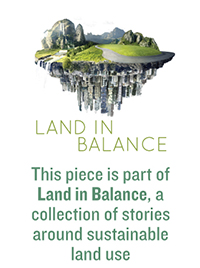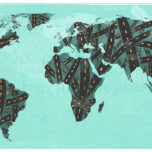February 18, 2020 —  This piece was excerpted from Rainforest:Dispatches From Earth’s Most Vital Frontlines by Tony Juniper, Copyright © Tony Juniper. Reproduced by permission of Island Press, Washington, D.C.
This piece was excerpted from Rainforest:Dispatches From Earth’s Most Vital Frontlines by Tony Juniper, Copyright © Tony Juniper. Reproduced by permission of Island Press, Washington, D.C.
The continuing clearance and degradation of tropical rainforests is not inevitable: It can be stopped and reversed. What follows is a description of seven strategies that have been shown to work.
1. Multiple Stakeholders
In the Amani Forest of Tanzania, “islands” of vegetation have been likened to the Galápagos Islands because of the exceptionally rich wildlife they support.
In the 1970s some conservationists believed it to be doomed by logging, farming and the expansion of tea plantations. In 1997, however, the forest was protected in the Amani Nature Reserve. Today it hosts a thriving research station.
The Amani Forest’s remarkable turnaround shows the benefits of multiple stakeholders being involved — in its case, local communities, the national government, scientific bodies, conservation groups and the international aid community.
2. Company (and Country) Policy
A number of multinational companies have adopted zero deforestation policies, often influenced by consumers. They include Johnson & Johnson, Unilever, Colgate-Palmolive, Krispy Kreme, Dunkin’ Donuts, McDonald’s, Nestlé. Hershey’s and Mars.
These commitments might end the anonymous purchase of ingredients from globalized markets, instead sourcing on the basis of where and how they are produced. And more than 60 countries are implementing programs under the auspices of REDD, with partnerships building between governments, companies, local communities and conservation and development groups.
3. New Technologies
New technologies are increasingly able to reveal change in forest cover in near-real-time, a helpful tool to fight corruption.
One of the key technology initiatives is Global Forest Watch, led by the World Resources Institute. In the past 10 years its capability has been transformed by access to the entire NASA Landsat archive, Europe’s Sentinel satellite program and Google’s computing cloud.
The main Global Forest Watch map reveals where deforestation has been most intense. Organizations can use the information for conservation purposes, including Interpol to crack down on shipments of illegally cut timber. Campaigners can use it to put pressure on companies, governments and international agencies.
4. Restoration for Social Good
Under the Bonn Challenge, countries and others signed up to goals to protect remaining forests and to increase forest cover by 3.5 million square kilometers (1.4 million square miles) by 2030. Although these are ambitious goals, progress is being made.
Importantly, the Bonn Challenge has been established not only as a vehicle for the recovery of forests but also to promote national development. This is for most tropical countries an essential frame for action. It is a fact of political life that poverty reduction generally trumps environmental priorities, so explicitly pursuing forest conservation and restoration because it is good for economic and social reasons is vital.
5. Protect and Conserve
The establishment of national parks, ecological reserves, indigenous territories and other designations aimed at the conservation of forests has over the decades made a huge positive difference.
Disputes and conflicts have sometimes accompanied their designation, for example, in curtailing local people’s rights of access. Thoughtful and inclusive planning can resolve at least some such conflicts. Enforcement of existing rules, including those to prevent poaching and maintain the integrity of protected areas, is also key.
6. Carbon Offsets
The world will be flying more in the decades ahead — and flights are for many in the developed world the largest part of an individual’s (and often a business’s) carbon footprint. If aviation is going to contribute to meeting global carbon reduction goals, there is also going to be a need for offsets.
Carbon held in natural systems, including tropical rainforests and the peat beneath them, is vital. Might it be possible to use money from a carbon charge on flight tickets to pay for rainforest protection and restoration? It seems to me that it has to be considered, even if a workable scheme won’t be perfect.
7. Innovative Financing
Long-term finance could come from investments in sustainable supply chains from multinational companies, including those behind global chocolate and coffee brands. Trust funds built up from royalties paid to governments by mining companies exploiting valuable ore bodies in or near rainforests could help. Small levies on ecotourism would be another source. Lottery money could make a difference, as could fines charged through crackdowns on illegal activities. There could be payments for ecosystem services — for example, from water companies receiving pure water from intact forests.
These and other sources of finance could add up to far more than the profits involved in destroying the forest. And such sums devoted to forest conservation would be money well spent, considering the wide range of benefits that would result.
The Road Ahead
The fact that I can paint this relatively optimistic picture of the road ahead says a great deal about how far the world has come in a very short time. When I began my campaign work for the rainforests back in 1990 I wouldn’t have thought such progress would be possible. Today, however, the case for the rainforests has been successfully made and action is being taken. A corner is being turned.
The new road ahead is a long one. Going down it as quickly as we can will be vital for protecting tropical rainforests and people. Should we drive hard and fast, we could secure the bargain of the century — climatic stability, water security, energy and food security, reduced social and political chaos and misery, the very future of life on Earth.
We know all we need to know to do this. What it requires now is for all of us to join in with this historic task. This is not only a call to action for company executives and government ministers, but all of us, in looking carefully at who we vote for, what we eat and consume. After all, there’s no reason we must continue to watch the inexorable decline of the tropical rainforests. We can save most of what is left and put back much of what’s gone, if we want to.
Editor’s note: The views expressed here are those of the author and not necessarily of Ensia. We present them to further discussion around important topics. We encourage you to respond with a comment below, following our commenting guidelines, which can be found on this page. In addition, you might consider submitting a Voices piece of your own. See Ensia’s Contact page for submission guidelines.
Related Posts
Ensia shares solutions-focused stories free of charge through our online magazine and partner media. That means audiences around the world have ready access to stories that can — and do — help them shape a better future. If you value our work, please show your support today.
Yes, I'll support Ensia!




